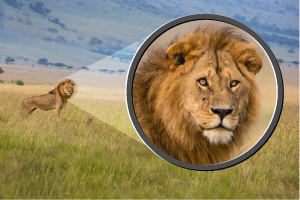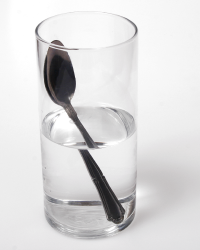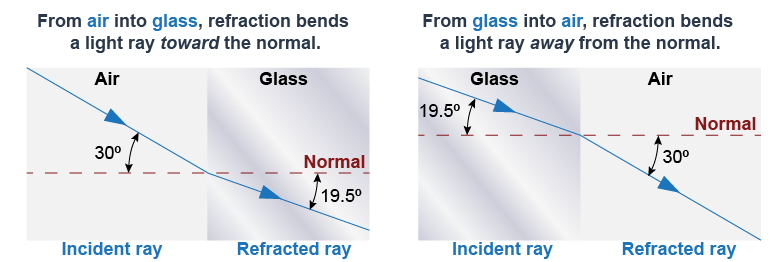|
 Imagine observing a distant lion in a telescope. Through the lens the lion appears close enough to bite you, yet the actual lion is safely 50 m distant. The apparent closeness of the image in the telescope is an illusion created by bending light rays. The illusion works because we “see” objects through the light reflected from objects. Anything that changes the light between the object and our eyes, such as refraction, can make objects appear larger, smaller, closer, inverted, or otherwise distorted.
Imagine observing a distant lion in a telescope. Through the lens the lion appears close enough to bite you, yet the actual lion is safely 50 m distant. The apparent closeness of the image in the telescope is an illusion created by bending light rays. The illusion works because we “see” objects through the light reflected from objects. Anything that changes the light between the object and our eyes, such as refraction, can make objects appear larger, smaller, closer, inverted, or otherwise distorted. 
|
Refraction
|
 Refraction is the bending of light rays, usually upon crossing a boundary between different materials such as air and glass or water. The refraction is caused by a change in the speed of light as it passes from one material into another. A ray of light that approaches an interface is refracted when it changes direction upon crossing the interface. A spoon in a glass of water is an excellent example of refraction. The spoon is not actually broken by the water surface, but it appears that way because the air–water boundary refracts light rays. The part of the spoon that is under water appears in a different place because light reflected from the spoon is refracted as it passes from the water to glass to air.
Refraction is the bending of light rays, usually upon crossing a boundary between different materials such as air and glass or water. The refraction is caused by a change in the speed of light as it passes from one material into another. A ray of light that approaches an interface is refracted when it changes direction upon crossing the interface. A spoon in a glass of water is an excellent example of refraction. The spoon is not actually broken by the water surface, but it appears that way because the air–water boundary refracts light rays. The part of the spoon that is under water appears in a different place because light reflected from the spoon is refracted as it passes from the water to glass to air. 
|
To describe refraction we consider a single incident ray approaching a boundary between two transparent materials. The normal is an imaginary line perpendicular to the boundary and passing through the point where the light ray crosses. When light passes from air into water we observe that the light rays bend toward the normal. When light passes from water into air we observe that the light rays bend away from the normal. 
|

|
Looking at different materials we observe that incident light rays at the same angle are refracted by different amounts. A light ray with an angle of incidence of 30° might be deflected by 10.5° when passing from air into glass. The same incident ray is deflected by only 7.9° when passing from air into water. The ability to refract light is determined by a material’s index of refraction. The index of refraction is greater for glass (1.5) than for water (1.33); therefore, light is refracted more strongly in glass compared to water. 
|
When light passes from water to air, is the refracted ray bent toward or away from the normal?
 |
It is refracted away from the normal when light passes from water to air. This is the reverse of the case in which light passing from air to water is bent toward the normal. 
|

